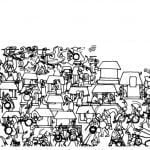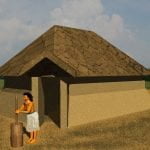The populations of Maya cities and countryside exploded after the mid-Sixth century hiatus. Several cities reached over 100,000 people. According to NASA archaeologist Tom Sever, the Mayan civilization in Mesoamerica was one of the densest populations in human history. At its zenith around 800 AD, the total population was probably in the range of 22 million. Prior to the analysis by NASA most archaeologists assumed that the total population was in the range of 10 million.
Slavery: Paralleling the population growth was general affluence, which enabled the Maya elite to import and export commodities and artistic creations to and from long distances. The carrying of commodities between cities was all done by slaves. In fact, virtually all manual labor, except farming, was done by slaves. At least 20% of the population were slaves; more likely the figure was in the range of 40%. The percentage of slaves in ancient Rome was 40%. There were many counties in the antebellum South with over half their population being slaves. In 1710 60% of South Carolina’s population was enslaved. On the eve of the Civil War, 49% of the population of Mississippi was enslaved.
Chontal Maya traders would have required huge inventories of slaves to carry their goods to the cities in the interior and paddle their boats in the ocean and in rivers. They also would have been in an ideal position to be directly involved with the slave trade. Their larger boats could make raids on less advanced peoples living outside of Mesoamerica.
Salt: The most important commodity brought into the interior was salt. The region contains salt domes, but very few can be seen from the surface. Most salt was evaporated from salt water. The Chontal Maya were in an ideal position to corner the salt trade. Their trading centers were on the coast and they were based outside the heartland where various alliances of cities were frequently at war. Perhaps the Chontal Maya required at least 100,000 slaves to dry salt, paddle it to distant ports and then haul it to inland cities. Over time salt brought great wealth to its merchants. While the Classic Maya cities bled themselves to death through incessant warfare, the Chontal Maya merchants grew ever more powerful.
Collapse: A series of sensationalized television documentaries have been produced in recent years that give the impression that one day the Maya civilization ceased to exist. Many Classic Maya ciites rapidly collapsed during the 800s AD, but not all. The last long calendar dates on a Maya stela was made in 910 AD at the city of Itzimté (Corn People) and 998 AD in the Osario Temple at Chichen Itza. However, Chichen Itza reached its zenith in population and political influence around 1150 AD. The cylindrical Observatory was not built until perhaps 1000 AD or later. Major construction ceased around 1250 AD, but it was still occupied when the Spanish arrived in the 1500s. Other Maya cities in northern Yucatan continued to thrive throughout the collapse of cities in the south, onto the early 1500s, when horrific smallpox plagues swept through the region.

Putun Mayas: Many cities in the Maya Highlands and Southern Lowlands were abandoned, but Puton Mayas rose to dominance throughout the region in their place. Putun is a generic label for several Maya groups originally involved in regional trade that used the wealth gained to replace the old aristocracy. Being of commoner origin, they apparently did not pretend to be gods. They also did not build as many stone architectural monuments, but new construction continued in the northern Yucatan Peninsula.
Even after construction of major public works ceased at Chichen Itza, its main port on Cerritas Island continued to prosper. Cerritas is due south of Mobile Bay, Alabama.

Corner door houses: Many of the Native American houses of the Southern Highlands, prior to the arrival of the Cherokees in the 1700s, had a peculiar trait. Their doors were constructed on one corner. The location of the door makes no sense structurally. They possibly weakened the frame, and at the least, were more difficult to construct. Archaeologists through the decades have apparently not given much thought to this architectural detail. It has a connection to the Mayas.
For unknown reasons, the Itza Maya commoners also built houses with corner doors. These odd houses show up in a mural at Chichen Itza. They provide strong evidence that Itza Maya commoners did seek refuge in the mountains of the Southeastern United States.
